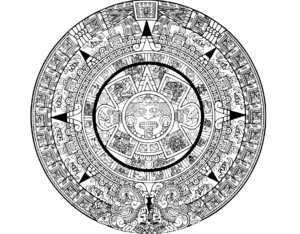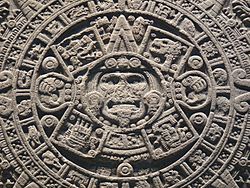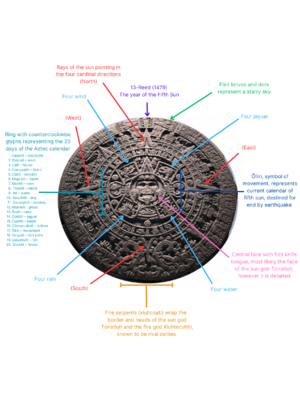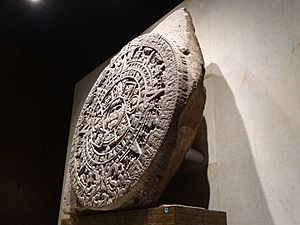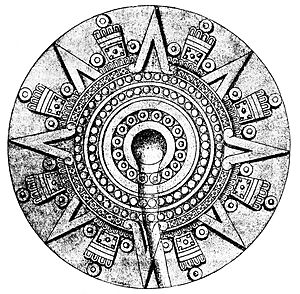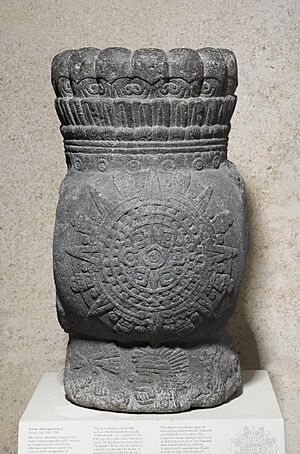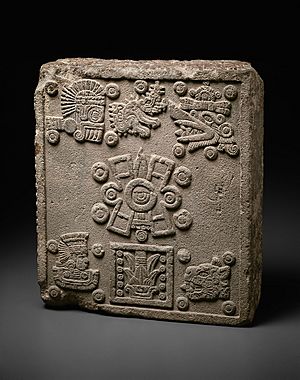Aztec sun stone facts for kids
Quick facts for kids Mexica sun stone |
|
|---|---|
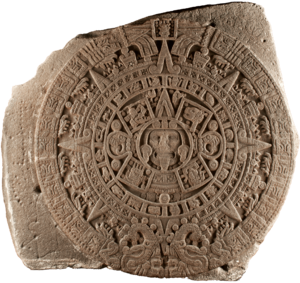
|
|
| Material | Basalt |
| Created | Sometime between 1502 and 1520 |
| Discovered | 17 December 1790 at El Zócalo, Mexico City |
| Present location | National Anthropology Museum (Mexico City) |
| Period | Post-Classical |
| Culture | Mexica |
The Aztec Sun Stone (also called Piedra del Sol in Spanish) is a famous ancient stone carving made by the Mexica people. The Mexica were the main group of the Aztec Empire. This amazing sculpture is now kept at the National Anthropology Museum in Mexico City. It's one of the most well-known pieces of Aztec art!
The stone is huge! It's about 3.6 meters (12 feet) wide and 98 centimeters (3 feet) thick. It weighs a massive 24,590 kilograms (over 54,000 pounds). That's like 12 cars! After the Spanish conquered the Aztec Empire, this giant stone was buried in the main square of Mexico City, called the Zócalo. It was found again on December 17, 1790, while workers were fixing the Mexico City Metropolitan Cathedral. After it was found, the Sun Stone was placed on an outside wall of the cathedral. It stayed there until 1885. Experts first thought the stone was carved in the 1470s. But newer studies suggest it was made between 1502 and 1521.
Contents
Discovering the Aztec Sun Stone
The Mexica people carved this huge stone at the end of their time, known as the Mesoamerican Postclassic Period. We don't know the exact date it was made. But a symbol of the Aztec ruler Moctezuma II on the stone suggests it was carved during his rule (1502 to 1520).
Historians aren't sure who carved it or why it was made. But old writings mention a very large stone being carved by the Mexica. One writer, Diego Durán, said that Emperor Axayacatl was busy carving a "famous and large stone." This stone had "figures of the months and years, days and weeks" carved into it. Another writer, Juan Torquemada, wrote that Moctezuma Xocoyotzin (Moctezuma II) ordered a huge rock to be brought to Tenochtitlan (the Aztec capital). But it fell into a canal on the way.
Where Did the Stone Come From?
The rock for the Sun Stone came from the Xitle volcano. It was likely found near San Ángel or Xochimilco. In 1893, a geologist named Ezequiel Ordóñez confirmed this. He said it was a type of rock called olivine basalt. Thousands of people probably dragged this giant stone up to 22 kilometers (14 miles) to the center of Mexico-Tenochtitlan.
Buried and Rediscovered
After the Spanish conquest, the stone was moved to an area near the Templo Mayor (the main Aztec temple). It lay uncovered for many years. Later, an important church leader, Alonso de Montúfar, ordered the Sun Stone to be buried. He wanted people to forget about the old Aztec sacrifices.
In the late 1700s, the leader of New Spain (Mexico), Juan Vicente de Güemes, started fixing up Mexico City. Workers were building new streets and improving the city. On December 17, 1790, during these repairs, the Sun Stone was found! It was only about 40 centimeters (16 inches) under the ground.
A scholar named Antonio de León y Gama came to see the discovery. He studied the stone and tried to understand its meaning. He was the one who first called it the "Aztec Calendar." He thought it was a public calendar. León y Gama convinced the church not to bury the stone again. He argued that old monuments were important to study and display, just like in Italy. Thanks to him, the stone was put on public display.
The Stone's Journey Through Time
On July 2, 1791, the Sun Stone was placed next to the west tower of the Mexico City Metropolitan Cathedral. Many people saw it there, including the famous explorer Alexander von Humboldt. He studied its carvings. Some Mexican stories say that during the Mexican–American War, American soldiers used the stone for target practice. But there's no proof of this damage. The American general, Winfield Scott, even thought about taking it to Washington D.C. as a war prize!
In 1885, the stone was moved to a museum on Moneda Street. People were a bit upset that this public symbol was "locked away."
Finally, in 1964, the Sun Stone was moved to the National Museum of Anthropology. It's now the main attraction in the museum's Mexica Hall. You can even see parts of the Sun Stone on different Mexican coins today!
For a long time, people thought the Sun Stone was the biggest Aztec carving. But then, a huge stone of the earth goddess Tlaltecuhtli was found. It measures 4 by 3.57 meters (13 by 11.7 feet). This new discovery showed that the Sun Stone wasn't the largest after all.
Understanding the Sun Stone's Symbols
The carvings on the Sun Stone tell us about the Mexica people's beliefs about the universe. It shows how important violence and war were to them. It also explains their ideas about how time works and how gods and humans are connected. The Aztec leaders used these ideas to keep control over their people. The Sun Stone was a powerful visual tool for this.
The Center of the Stone
In the middle of the stone, you'll often see what people believe is the face of the sun god, Tonatiuh. This face is inside a symbol that means "movement" (Ōllin in Nahuatl, the Aztec language). This symbol represents the current age of the world. Some experts think the face might be the earth monster, Tlaltecuhtli, or a mix of different gods. This debate is about how the stone was used in Aztec rituals. The central figure holds a human heart in each clawed hand. Its tongue is shown as a stone sacrificial knife (Tecpatl).
Four Past Worlds or Eras
Around the central god, there are four squares. These squares show the four past worlds or eras that came before our current one, "Four Movement" (Nahui Ōllin). The Aztecs believed each era ended with the world and humans being destroyed. Then, a new era would begin.
- The top right square shows "Four Jaguar" (Nahui Ōcēlotl). This era ended when monsters ate all humans after 676 years.
- The top left square shows "Four Wind" (Nahui Ehēcatl). After 364 years, strong winds destroyed the earth, and people turned into monkeys.
- The bottom left square shows "Four Rain" (Nahui Quiyahuitl). This era lasted 312 years. It ended with a rain of fire, which turned humans into turkeys.
- The bottom right square shows "Four Water" (Nahui Atl). This era lasted 676 years. It ended when the world flooded, and all humans became fish.
The numbers of years (676, 364, 312) are all multiples of 52. This is important because 52 years was the length of one Aztec "century." So, 676 years means 13 Aztec centuries, 364 years means 7, and 312 years means 6 Aztec centuries.
Among these four squares, there are three other dates: "One Flint" (Tecpatl), "One Rain" (Atl), and "Seven Monkey" (Ozomahtli). There's also a Xiuhuitzolli symbol, which is a ruler's turquoise crown. These dates might have been important for both history and the universe. The crown might even be part of the name of the Aztec ruler, Moctezuma II.
The First Ring of Days
The first circle on the stone shows the symbols for the 20 days of the Aztec solar calendar (xiuhpohualli). This stone isn't a working calendar. Instead, it uses these symbols to show the Aztec ideas about time and how it connects to their cosmic stories. Starting from the symbol to the left of the central point, these symbols are read counterclockwise:
- 1. Cipactli – crocodile
- 2. Ehécatl – wind
- 3. Calli – house
- 4. Cuetzpallin – lizard
- 5. Cóatl – serpent
- 6. Miquiztli – skull/death
- 7. Mázatl – deer
- 8. Tochtli – rabbit
- 9. Atl – water
- 10. Itzcuintli – dog
- 11. Ozomatli – monkey
- 12. Malinalli – herb
- 13. Ácatl – cane
- 14. Océlotl – jaguar
- 15. Cuauhtli – eagle
- 16. Cozcacuauhtli – vulture
- 17. Ollín – movement
- 18. Técpatl – flint
- 19. Quiahuitl – rain
- 20. Xóchitl – flower
|
|
The Second Ring
This ring has several square sections, each with five dots. Above these squares are small arch shapes that look like feather decorations. Above those are pointed arches grouped in fours. There are also eight angles that divide the stone into eight parts. These probably show the sun's rays pointing in different directions.
The Outer Ring of Serpents
Two fire serpents, called Xiuhcoatl, fill almost this entire outer ring. You can tell them by the flames coming from their bodies. Their bodies are made of square segments, and their tails have points. They also have unusual heads and mouths. At the very bottom of the stone, human heads come out of the serpents' mouths. Experts have tried to figure out who these human heads are, but they don't all agree. One idea is that the two serpents represent two gods who were part of the story of how the fifth and current "sun" (world) was created: Quetzalcoatl and Tezcatlipoca. The serpents' tongues are touching. This might show that time continues forever and that these gods are always in a power struggle over the world.
At the top of this ring, a square carved between the serpents' tails shows the date Matlactli Omey-Ácatl ("13-reed"). This date is thought to be 1479. This was the year the Fifth Sun began in Teotihuacan during the rule of Axayácatl. It also might be the year this huge Sun Stone was carved.
The Edge of the Stone
The very edge of the stone is about 20 centimeters (8 inches) wide. It has a band of dots and what look like flint knives. This part of the stone is thought to represent the starry night sky.
How the Sun Stone is Used Today
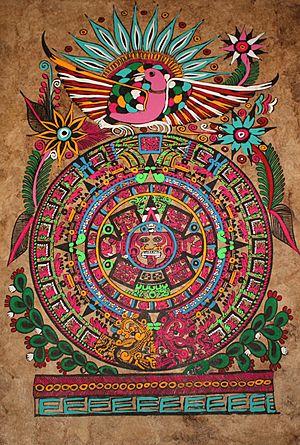
The image of the Sun Stone is shown on Mexican money. It's on the front of the Mexican 20 Peso gold coin. Different parts of the Sun Stone are also on other Mexican coins today. Each coin has a different section of the stone.
The Sun Stone image has also become a symbol for modern Mexican culture. It's used in folk art and represents Mexican identity.
In 1996, the Mexico national football team used a picture of the Sun Stone on their soccer jerseys. Each shirt had the colors of the Mexican flag: green, white, and red. They wore these jerseys until the 1998 World Cup.
Even Elvis Presley had a jumpsuit with the Aztec Sun Stone on it! He wore it in his last concerts in 1977. People often call this suit the "Mexican Sundial suit."
The Sun Stone and History
After the Spanish conquered the Aztec Empire in 1521, they looked down on the Aztec culture. The Aztecs had reasons for their sacrifices, but the Spanish were shocked by them. They wrote stories that made the Aztecs seem like bloodthirsty and uncivilized people. The Spanish destroyed, removed, or buried Aztec objects like the Sun Stone. This sent a message that Aztec culture was not as good. This idea still affects people today.
Mexico City was built over the Aztec capital of Tenochtitlan. The Sun Stone was lost for centuries until it was found in 1790. When it reappeared, people became interested in Aztec culture again. But because Western culture had influenced Mexico for hundreds of years, placing the stone next to the main cathedral caused some debate. Even though the stone was being honored, putting it in the shadow of a Catholic church made some people feel that the Spanish still controlled Aztec culture.
Another discussion is about how cultural objects are shown as "art." Some experts say that when we call something "art" from another culture, we might only value how it looks. We might forget its true history and cultural meaning. The Sun Stone was not made as an art object. It was a tool for Aztec rituals and a political symbol. By calling it a "sculpture" and showing it standing up (when it was originally used flat), we see it through a Western view. This can make it lose some of its original meaning. How we display and talk about the Sun Stone today is part of a bigger discussion about how to understand and respect non-Western cultures.
Other Sun Stones
There are other ancient stones and sculptures that look similar to the Aztec Sun Stone. Most of them were found under Mexico City. Many of these are called temalacatl. These were large stones used for special combat and sacrifices. Some experts think the Aztec Sun Stone might also be one of these.
Temalacatls: Sacrificial Stones
The Stone of Tizoc has carvings on its top that look like the Sun Stone. Many of its designs are the same. This stone is also at the National Anthropology Museum, in the same room as the Aztec Sun Stone.
The Stone of Motecuhzoma I is another huge stone. It's about 3.6 meters (12 feet) wide and 0.9 meters (3 feet) tall. It also has the 8-pointed compass design. In the center, it shows the sun god Tonatiuh with his tongue sticking out.
The Philadelphia Museum of Art has a smaller "Calendar Stone." It also has the calendar symbols. Its side has two bands. The lower band shows Venus with knives for eyes. The upper band has two rows of star symbols.
The Yale University Art Gallery has a similar stone called the Altar of the Five Cosmogonic Eras. It has similar carvings around the central compass design. But it's a rectangle instead of a circle. This allowed artists to add the symbols of the four past suns at the corners. It looks a bit like the Coronation Stone of Moctezuma II.
Calendar Symbols in Other Objects
The Coronation Stone of Moctezuma II (also called the Stone of the Five Suns) is a sculpture about 55.9 x 66 x 22.9 cm (22 x 26 x 9 inches). It's at the Art Institute of Chicago. It has similar carvings to the Aztec Sun Stone. It shows 4-Movement in the center, surrounded by 4-Jaguar, 4-Wind, 4-Rain, and 4-Water. These all represent one of the five "cosmic eras." The year sign 11-Reed suggests it was made in 1503, the year Moctezuma II became ruler. The date 1-Crocodile might be the day of his ceremony.
The Throne of Montezuma also uses the compass design. This monument is at the National Museum of Anthropology with the Aztec Sun Stone. It was found in 1831 under the National Palace in Mexico City. It's about 1 meter (3 feet) square at the bottom and 1.23 meters (4 feet) tall. It's carved like a temple. The year at the top, 2-House, refers to the founding of Tenochtitlan in 1325 CE.
The compass design with Ollin can also be found on stone altars used for the New Fire ceremony. Another object, the Ceremonial Seat of Fire, looks similar. But it doesn't have the central Ollin image. Instead, it shows the Sun.
The British Museum has a cuauhxicalli (a ritual vessel). It might show the balance between two opposites: the power of the sun (with a solar face) and the power of the moon (with moon symbols on the back). This is similar to the Templo Mayor temple, which had statues of the god Huitzilopochtli and the goddess Coyolxauhqui.
|
|
|||||||||||||
See also
 In Spanish: Piedra del Sol para niños
In Spanish: Piedra del Sol para niños
- Coyolxauhqui stone disk


